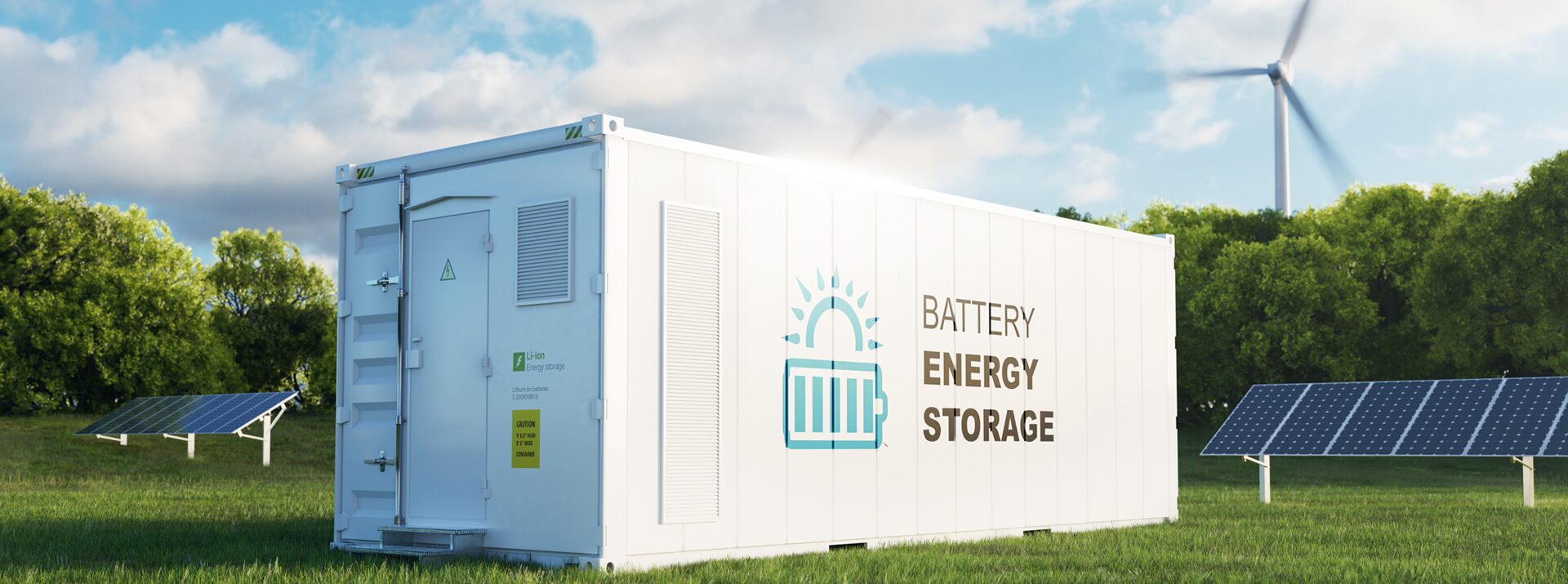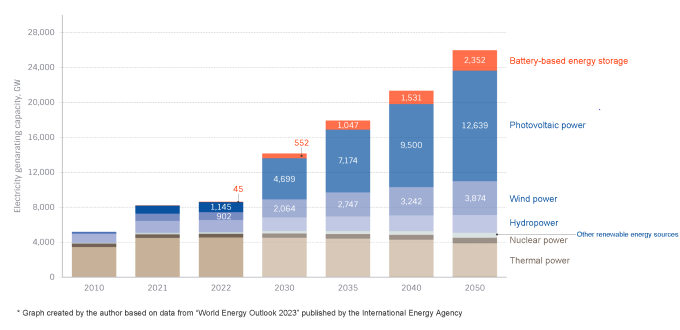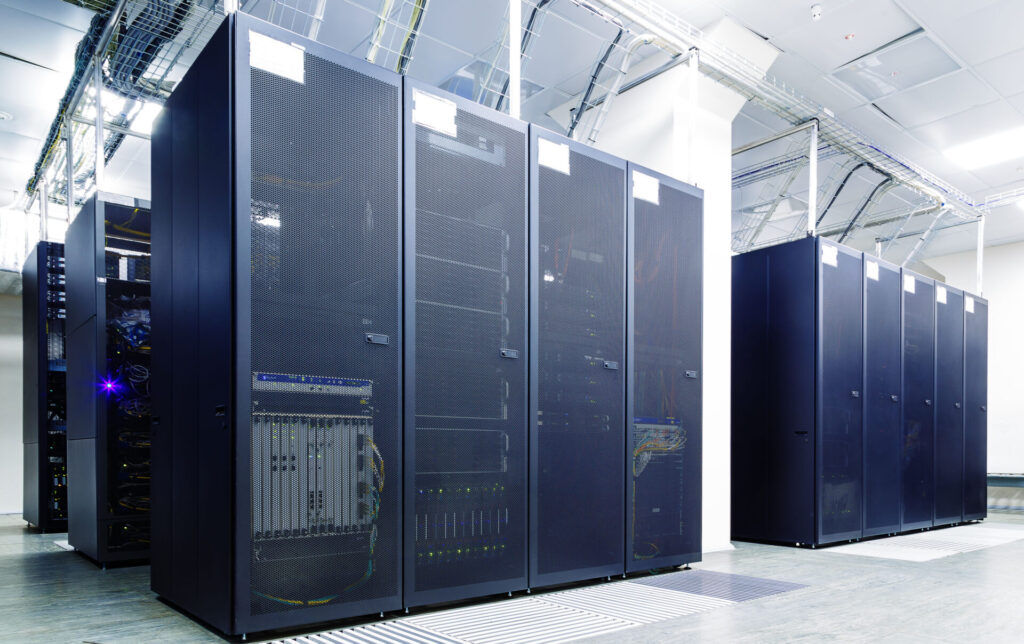
- Electronic Components
Energy Storage Systems (ESSs) Utilizing Lithium-ion Batteries
Contents
Role and importance of Energy Storage Systems (ESSs)
Energy Storage Systems (ESSs) store electricity temporarily and supply it as needed to help balance electricity supply and demand.
The recent push towards decarbonization has been promoting the use of renewable energy, increasing the importance of ESSs. Renewable energy sources, such as photovoltaic and wind energy, are vital, although their electricity output can vary with weather conditions and time of day. Therefore, ESSs are essential to absorb these fluctuations and ensure a stable energy supply. A research firm estimated that in 2022, photovoltaic and wind power systems accounted for over 20% of global power generation, a figure expected to approach 50% by 2030. As renewable energy gains a larger share of total energy output, the demand for energy storage is anticipated to rise sharply. (Source: World Energy Outlook 2023 – Analysis – IEA)

(by power generation technology, Stated Policies Scenario)
Factors contributing to the increase in Energy Storage Systems
There are four factors contributing to the increase in ESSs.
- Growth in renewable energy use
As more renewable energy systems are introduced, ESSs play a crucial part in stabilizing electricity supply-demand balance , and enhancing the flexibility of electricity systems. The expanding use of ESSs at photovoltaic power stations is driving market growth for ESSs within the electric power generation sector. - Advancements in energy storage technology
Innovations in lithium-ion batteries have boosted the various capabilities of ESSs. Specifically, they have increased their energy density and charging rates, improved their cycle life, and enhanced their safety. These enhancements have facilitated the broader adoption of ESSs. - Energy policy incentives
Many countries, especially developed ones, have implemented polices that incentivize the introduction of renewable energy. The United States, for example, enacted the Inflation Reduction Act (IRA) in 2022 to strongly support the introduction of renewable energy. Regarding grid-scale batteries*, energy storage capacity has more than doubled in the past year and is expected to double again by 2024.
* Storage batteries directly connected to photovoltaic or wind power stations.
(Source) Building a Thriving Clean Energy Economy in 2023 and Beyond - Increasing power demand
When new photovoltaic and wind power stations are created to meet the future rise in power demand, it will be essential to use ESSs to regulate the balance between supply and demand. This helps offset the variability in output due to weather conditions and time of day.
Operators introducing ESSs
Photovoltaic and wind energy, known as Variable Renewable Energy (VER), produce varying amounts of electricity depending on the weather and time of day.
Similarly, power demand fluctuates with the seasons and by hour. For example, in Japan, demand increases during summer and winter due to air conditioning needs. It also varies between day and night.
Additionally, electricity is difficult to store in large quantities. Therefore, the power produced must be regulated to match consumption (a principle known as “equal amounts at a time”). In light of these facts, various operators are introducing ESSs into their facilities. By doing so, they can advantageously stabilize energy supply, reduce power costs, and lessen environmental impact as well as balancing energy supply and demand.
- Electric power companies
They require stable power supplies that can quickly adjust to power demand fluctuations. - Renewable energy-based electricity generators (photovoltaic, wind power, etc.)
They are obligated to manage output variability for a stable energy supply. - Large-scale facilities (factories; commercial and medical facilities; municipal, government, and public facilities)
They need to stabilize energy supplies and secure emergency power. - Decarbonization-focused companies
They aim to use surplus power efficiently to reduce CO2 emissions and introduce renewable energy.
Large-scale energy storage using lithium-ion batteries
Traditional large-scale energy storage, such as pumped storage hydropower, faces challenges including long construction periods and siting restrictions. Recently, however, battery-based power storage has become more attractive due to falling battery prices, driven by the popularization of electric vehicles and increasing demand for power storage.
Storage batteries offer several advantages: they respond quickly, have long discharging periods, face no restrictions on installation locations, and require short installation periods. Specifically, for instantaneous supply-demand adjustments and peak shifting, quickly rechargeable lithium-ion batteries with high energy density and longevity are commonly used.
Major battery types include lithium-ion (LiB), sodium-sulfur (NAS), and redox flow (RF). Lithium-ion batteries from electric vehicles are particularly expected to be repurposed into storage batteries.
The global output of energy storage systems was 223 GW in 2022 and is projected to reach approximately 512 GW by 2030. Despite this growth, these figures are still modest compared to the total global power output. The output of pumped storage hydropower is expected to reach about 240 GW by 2030, highlighting the need for more storage batteries to support broader applications of renewable energy. (Source: Energy Storage Systems Market Size & Share Report, 2030 (grandviewresearch.com))
Pumped storage hydropower faces geographical restrictions and environmental concerns, which has increased interest in battery-based large-scale energy storage. However, storage batteries degrade from repeated charging and discharging, making pumped storage hydropower more cost-effective over time. Reducing the costs of storage batteries, including their replacement, will be key to their broader adoption.
Importance of secondary protection fuses
The previous sections explored storage battery systems that utilize lithium-ion batteries. To ensure the safety of these batteries, protection systems are crucial. One solution is the use of secondary protection fuses. These fuses automatically shut off current in the event of overcurrent or short circuits, preventing damage to the system. This protection mitigates risks such as thermal runaway in lithium-ion batteries, which can be caused by overcharging or overdischarging, thus enhancing overall safety.
When selecting a fuse, it is crucial to consider its maximum continuous current, breaking capacity, and operating temperature range. Properly matching these parameters allows the fuse to maximize its protective function, contributing to the long-term reliability and performance of the lithium-ion battery system.
In infrastructure-related applications, reducing the frequency of maintenance is directly linked to cost reductions. Therefore, installing appropriate secondary protections not only enables safe system shutdown but also reduces maintenance costs.
For the evolution and market penetration of energy storage systems, selecting and designing fuses play a key role in enhancing the safety and reliability of these systems. Going forward, the efficient management of secondary protection fuses will become increasingly important in energy supply.
- SHARE
 Back to top
Back to top  Contact us
Contact us 
















